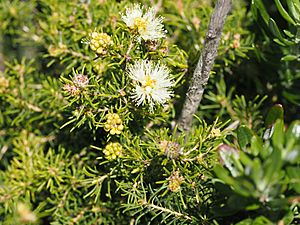Coastal honeymyrtle facts for kids
Quick facts for kids Coastal honeymyrtle |
|
|---|---|
 |
|
| M.systena leaves and flowers | |
| Scientific classification | |
| Genus: |
Melaleuca
|
| Species: |
systena
|
The Coastal Honeymyrtle, also known as Melaleuca systena, is a special plant from the myrtle family. It grows only in the south-west part of Western Australia. This small bush has lots of leaves close together. In spring, it gets many white or yellow flowers at the ends of its branches. It used to be called Melaleuca acerosa.
What it Looks Like
The Coastal Honeymyrtle usually grows as a small bush. It can sometimes reach up to 2 m (7 ft) tall. Its leaves grow in an alternating pattern. They are long and narrow, or sometimes shaped like an egg. The leaves are also a bit thick or fleshy. They are about 4–15.5 mm (0.2–0.6 in) long and 0.6–1.4 mm (0.02–0.06 in) wide. Some leaves are smooth, while others have tiny hairs. They often get narrower towards the tip.
The flowers are white to creamy-yellow. They grow in round clusters at the ends of the branches. These branches keep growing even after the flowers bloom. Sometimes, flowers also appear where the upper leaves meet the stem. Each flower cluster can be up to 20 mm (0.8 in) across. They usually have 3 to 9 groups of three flowers. You can see flowers in winter and summer, but they are most common in spring.
The petals are about 1.5–2.5 mm (0.06–0.1 in) long. They fall off as the flower opens. Inside the flower, there are five groups of stamens. Each group usually has 10 to 15 stamens. After flowering, the plant produces woody fruits. These fruits are shaped like small urns. They are about 3–6 mm (0.1–0.2 in) long. You can find them in small clusters along the stems.
How it Got its Name
The plant Melaleuca systena was first officially named in 1999. This was done by two scientists, Lyndley Craven and Brendan Lepschi. They published its name in a science journal called Australian Systematic Botany. However, this plant had been described before. In 1824, another scientist, Luigi Aloysius Colla, first described it. He called it Billottia acerosa.
Later, its name was changed to Melaleuca acerosa. But this name was not allowed because it had already been used for a different plant. That other plant's name was later changed to Calothamnus quadrifidus. So, to avoid confusion, the plant was given its current legal name, Melaleuca systena. The second part of the name, systena, comes from an Ancient Greek word. It means "tapering," which describes the shape of the plant's leaves.
Where it Grows
This type of melaleuca plant grows along the coast of Western Australia. You can find it between Shark Bay and Augusta. It lives in several different natural areas. These include the Avon Wheatbelt and the Swan Coastal Plain. It also grows in the Coolgardie, Geraldton Sandplains, Jarrah Forest, Warren, and Yalgoo regions. The plant likes to grow in sand. This sand is often found over sandstone or laterite rock. It also thrives on stable sand dunes near the coast.
Conservation Status
The Coastal Honeymyrtle is doing well. The Government of Western Australia's Department of Parks and Wildlife says it is "not threatened." This means there are plenty of these plants in the wild.
Images for kids
-
M. systena growing near Jurien Bay



